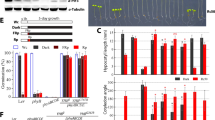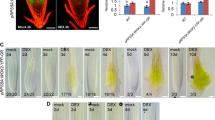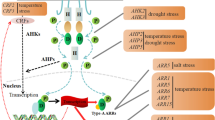Abstract
The regulation of signalling capacity, combined with the spatiotemporal distribution of developmental signals themselves, is pivotal in setting developmental responses in both plants and animals1. The hormone auxin is a key signal for plant growth and development that acts through the AUXIN RESPONSE FACTOR (ARF) transcription factors2,3,4. A subset of these, the conserved class A ARFs5, are transcriptional activators of auxin-responsive target genes that are essential for regulating auxin signalling throughout the plant lifecycle2,3. Although class A ARFs have tissue-specific expression patterns, how their expression is regulated is unknown. Here we show, by investigating chromatin modifications and accessibility, that loci encoding these proteins are constitutively open for transcription. Through yeast one-hybrid screening, we identify the transcriptional regulators of the genes encoding class A ARFs from Arabidopsis thaliana and demonstrate that each gene is controlled by specific sets of transcriptional regulators. Transient transformation assays and expression analyses in mutants reveal that, in planta, the majority of these regulators repress the transcription of genes encoding class A ARFs. These observations support a scenario in which the default configuration of open chromatin enables a network of transcriptional repressors to regulate expression levels of class A ARF proteins and modulate auxin signalling output throughout development.



Similar content being viewed by others
Data availability
The data including the source data that supports the finding of this study are available within the paper, its supplementary information files or publicly available datasets. Publicly available position weight matrices were obtained from the Jaspar and CisBP databases. Publicly available chromatin marking and accessibility datasets were acquired from the GEO and ArrayExpress databases with the following accession numbers: GSE24665, GSE24658, GSE7907, GSE24507, GSE50636, GSE24657, GSE24710, GSE19654, GSM2260231, GSM2260232, GSM2260235, GSM2260236, GSM2704255, GSM2704256, GSM2719200, GSM2719201, GSM2719202, GSM2719203, GSM2719204, GSM2719205, GSM1289362, GSM1289374, E-MTAB-4680, E-MTAB-4684 and GSM1289358.
Change history
23 December 2020
A Correction to this paper has been published: https://doi.org/10.1038/s41586-020-03066-x
References
Sagner, A. & Briscoe, J. Morphogen interpretation: concentration, time, competence, and signaling dynamics. Wiley Interdiscip. Rev. Dev. Biol. 6, e271 (2017).
Leyser, O. Auxin signaling. Plant Physiol. 176, 465–479 (2018).
Tiwari, S. B., Hagen, G. & Guilfoyle, T. The roles of auxin response factor domains in auxin-responsive transcription. Plant Cell 15, 533–543 (2003).
Petrásek, J. & Friml, J. Auxin transport routes in plant development. Development 136, 2675–2688 (2009).
Finet, C., Berne-Dedieu, A., Scutt, C. P. & Marlétaz, F. Evolution of the ARF gene family in land plants: old domains, new tricks. Mol. Biol. Evol. 30, 45–56 (2013).
Krogan, N. T., Marcos, D., Weiner, A. I. & Berleth, T. The auxin response factor MONOPTEROS controls meristem function and organogenesis in both the shoot and root through the direct regulation of PIN genes. New Phytol. 212, 42–50 (2016).
Berleth, T. & Jurgens, G. The role of the monopteros gene in organising the basal body region of the Arabidopsis embryo. Development 118, 575–587 (1993).
Przemeck, G. K., Mattsson, J., Hardtke, C. S., Sung, Z. R. & Berleth, T. Studies on the role of the Arabidopsis gene MONOPTEROS in vascular development and plant cell axialization. Planta 200, 229–237 (1996).
Schlereth, A. et al. MONOPTEROS controls embryonic root initiation by regulating a mobile transcription factor. Nature 464, 913–916 (2010).
Nagpal, P. et al. Auxin response factors ARF6 and ARF8 promote jasmonic acid production and flower maturation. Development 132, 4107–4118 (2005).
Gutierrez, L. et al. Phenotypic plasticity of adventitious rooting in Arabidopsis is controlled by complex regulation of AUXIN RESPONSE FACTOR transcripts and microRNA abundance. Plant Cell 21, 3119–3132 (2009).
Okushima, Y. et al. Functional genomic analysis of the AUXIN RESPONSE FACTOR gene family members in Arabidopsis thaliana: unique and overlap** functions of ARF7 and ARF19. Plant Cell 17, 444–463 (2005).
Harper, R. M. et al. The NPH4 locus encodes the auxin response factor ARF7, a conditional regulator of differential growth in aerial Arabidopsis tissue. Plant Cell 12, 757–770 (2000).
Rademacher, E. H. et al. A cellular expression map of the Arabidopsis AUXIN RESPONSE FACTOR gene family. Plant J. 68, 597–606 (2011).
Vernoux, T. et al. The auxin signalling network translates dynamic input into robust patterning at the shoot apex. Mol. Syst. Biol. 7, 508 (2011).
Hardtke, C. S. & Berleth, T. The Arabidopsis gene MONOPTEROS encodes a transcription factor mediating embryo axis formation and vascular development. EMBO J. 17, 1405–1411 (1998).
Roudier, F. et al. Integrative epigenomic map** defines four main chromatin states in Arabidopsis. EMBO J. 30, 1928–1938 (2011).
Gifford, M. L., Dean, A., Gutierrez, R. A., Coruzzi, G. M. & Birnbaum, K. D. Cell-specific nitrogen responses mediate developmental plasticity. Proc. Natl Acad. Sci. USA 105, 803–808 (2008).
Jay, F. et al. Misregulation of AUXIN RESPONSE FACTOR 8 underlies the developmental abnormalities caused by three distinct viral silencing suppressors in Arabidopsis. PLoS Pathog. 7, e1002035 (2011).
O’Malley, R. C. et al. Cistrome and epicistrome features shape the regulatory dna landscape. Cell 165, 1280–1292 (2016).
Ma, Y. et al. WUSCHEL acts as an auxin response rheostat to maintain apical stem cells in Arabidopsis. Nat. Commun. 10, 5093 (2019).
Zhao, Z. et al. Hormonal control of the shoot stem-cell niche. Nature 465, 1089–1092 (2010).
Leibfried, A. et al. WUSCHEL controls meristem function by direct regulation of cytokinin-inducible response regulators. Nature 438, 1172–1175 (2005).
Dharmasiri, N. et al. Plant development is regulated by a family of auxin receptor F box proteins. Dev. Cell 9, 109–119 (2005).
Kim, D.-H. & Sung, S. Polycomb-mediated gene silencing in Arabidopsis thaliana. Mol. Cells 37, 841–850 (2014).
Orosa-Puente, B. et al. Root branching toward water involves posttranslational modification of transcription factor ARF7. Science 362, 1407–1410 (2018).
Cho, H. et al. A secreted peptide acts on BIN2-mediated phosphorylation of ARFs to potentiate auxin response during lateral root development. Nat. Cell Biol. 16, 66–76 (2014).
Ptashne, M. Repressors. Curr. Biol. 17, R740–R741 (2007).
Jacob, F. & Monod, J. Genetic regulatory mechanisms in the synthesis of proteins. J. Mol. Biol. 3, 318–356 (1961).
Clough, S. J. & Bent, A. F. Floral dip: a simplified method for Agrobacterium-mediated transformation of Arabidopsis thaliana. Plant J. 16, 735–743 (1998).
Gaudinier, A. et al. Enhanced Y1H assays for Arabidopsis. Nat. Methods 8, 1053–1055 (2011).
Kim, J. H. et al. High cleavage efficiency of a 2A peptide derived from porcine teschovirus-1 in human cell lines, zebrafish and mice. PLoS ONE 6, e18556 (2011).
Trichas, G., Begbie, J. & Srinivas, S. Use of the viral 2A peptide for bicistronic expression in transgenic mice. BMC Biol. 6, 40 (2008).
George, E. O. & Mudholkar, G. S. On the convolution of logistic random variables. Metrika 30, 1–13 (1983).
Paponov, I. A. et al. Comprehensive transcriptome analysis of auxin responses in Arabidopsis. Mol. Plant 1, 321–337 (2008).
Siligato, R. et al. MultiSite Gateway-compatible cell type-specific gene-inducible system for plants. Plant Physiol. 170, 627–641 (2016).
Smetana, O. et al. High levels of auxin signalling define the stem-cell organizer of the vascular cambium. Nature 565, 485–489 (2019).
Brady, S. M. et al. A high-resolution root spatiotemporal map reveals dominant expression patterns. Science 318, 801–806 (2007).
Yadav, R. K., Girke, T., Pasala, S., **e, M. & Reddy, G. V. Gene expression map of the Arabidopsis shoot apical meristem stem cell niche. Proc. Natl Acad. Sci. USA 106, 4941–4946 (2009).
Yadav, R. K., Tavakkoli, M., **e, M., Girke, T. & Reddy, G. V. A high-resolution gene expression map of the Arabidopsis shoot meristem stem cell niche. Development 141, 2735–2744 (2014).
Oh, S., Park, S. & van Nocker, S. Genic and global functions for Paf1C in chromatin modification and gene expression in Arabidopsis. PLoS Genet. 4, e1000077 (2008).
Willing, E.-M. et al. Genome expansion of Arabis alpina linked with retrotransposition and reduced symmetric DNA methylation. Nat. Plants 1, 14023 (2015).
Deal, R. B. & Henikoff, S. A simple method for gene expression and chromatin profiling of individual cell types within a tissue. Dev. Cell 18, 1030–1040 (2010).
You, Y. et al. Temporal dynamics of gene expression and histone marks at the Arabidopsis shoot meristem during flowering. Nat. Commun. 8, 15120 (2017).
Lafos, M. et al. Dynamic regulation of H3K27 trimethylation during Arabidopsis differentiation. PLoS Genet. 7, e1002040 (2011).
Sullivan, A. M. et al. Map** and dynamics of regulatory DNA and transcription factor networks in A. thaliana. Cell Rep. 8, 2015–2030 (2014).
Lu, Z., Hofmeister, B. T., Vollmers, C., DuBois, R. M. & Schmitz, R. J. Combining ATAC-seq with nuclei sorting for discovery of cis-regulatory regions in plant genomes. Nucleic Acids Res. 45, e41 (2017).
Maher, K. A. et al. Profiling of accessible chromatin regions across multiple plant species and cell types reveals common gene regulatory principles and new control modules. Plant Cell 30, 15–36 (2018).
Sijacic, P., Bajic, M., McKinney, E. C., Meagher, R. B. & Deal, R. B. Changes in chromatin accessibility between Arabidopsis stem cells and mesophyll cells illuminate cell type-specific transcription factor networks. Plant J. 94, 215–231 (2018).
Thorvaldsdóttir, H., Robinson, J. T. & Mesirov, J. P. Integrative Genomics Viewer (IGV): high-performance genomics data visualization and exploration. Brief. Bioinform. 14, 178–192 (2013).
Robinson, J. T. et al. Integrative genomics viewer. Nat. Biotechnol. 29, 24–26 (2011).
Khan, A. et al. JASPAR 2018: update of the open-access database of transcription factor binding profiles and its web framework. Nucleic Acids Res. 46 (D1), D260–D266 (2018).
Weirauch, M. T. et al. Determination and inference of eukaryotic transcription factor sequence specificity. Cell 158, 1431–1443 (2014).
Berger, N., Dubreucq, B., Roudier, F., Dubos, C. & Lepiniec, L. Transcriptional regulation of Arabidopsis LEAFY COTYLEDON2 involves RLE, a cis-element that regulates trimethylation of histone H3 at lysine-27. Plant Cell 23, 4065–4078 (2011).
Yu, C.-P., Lin, J.-J. & Li, W.-H. Positional distribution of transcription factor binding sites in Arabidopsis thaliana. Sci. Rep. 6, 25164 (2016).
Goda, H. et al. The AtGenExpress hormone and chemical treatment data set: experimental design, data evaluation, model data analysis and data access. Plant J. 55, 526–542 (2008).
Acknowledgements
We thank F. Besnard, A. Larrieu and R. Azaïs for their help with data analysis and statistics; M. Herpola for RNA in situ hybridization analysis; G. Castiglione for help with root phenoty**; A. Mathelier for help with JASPAR; and D. Weijers for ARF transcriptional reporter lines. This work was supported by a joint INRA/University of Nottingham PhD grant to J.T.; ANR-2014-CE11-0018 grant and Human Frontier Science Program organization (HFSP) grant RPG0054-2013 to T.V.; a Royal Society University Research Fellowship and enhancement award (UF110249 and RGF\EA\180308) to A.B.; a starting grant from the Programme Avenir Lyon Saint Etienne (ANR-11-IDEX-0007) to F.R.; an HHMI Faculty Scholar fellowship to S.M.B.; ANR-10-LABX-49-01 and ANR-17-EURE-0003 to F.P.; ANR-18-CE12-0014-02 to T.V., F.R. and F.P.; and Aux-ID CNRS PICS grant to T.V., A.B. and E.F.
Author information
Authors and Affiliations
Contributions
A.B. and T.V. designed the study and supervised the work; J.T., F.P., F.R., E.F., S.M.B., A.B. and T.V. designed the experiments; J.T., A-M.B. and M.E.S. performed the eY1H screen with the help of S.P. and M.B.; J.T., J.H., E.C., C.S.G.-A., S.L. and G.B. performed all experiments in relation to TF biological activity characterization; J.L. performed the statistical analysis of the protoplast experiment and participated in all statistical analysis; O.S. and A.P.M. performed the in situ hybridization experiments; A.S. and F.P. performed TF binding site analysis; S.B. and E.F. performed the modelling analysis; J.M. and F.R. performed the epigenetic data analysis; all authors were involved in data analysis; J.T., A.B. and T.V. wrote the manuscript with inputs from all authors.
Corresponding authors
Ethics declarations
Competing interests
The authors declare no competing interests.
Additional information
Peer review information Nature thanks the anonymous reviewer(s) for their contribution to the peer review of this work.
Publisher’s note Springer Nature remains neutral with regard to jurisdictional claims in published maps and institutional affiliations.
Extended data figures and tables
Extended Data Fig. 1 Analysis of class A ARF expression in the RAM and the SAM using transcriptional reporter lines and in situ hybridization.
a–j, Confocal images showing expression of ARF5 (a, f), ARF6 (b, g), ARF7 (c, h), ARF8 (d, i) and ARF19 (e, j) in the RAM and the SAM using promoters that lack sequences downstream of the start codon but contain the long upstream sequences (pARF −intron::mVenus) (~3 kb for ARF6 and ARF7; 5 kb for ARF5, ARF8 and ARF19) (see Methods). For SAM images (f–j) an orthogonal projection is shown below to provide information about expression in different layers. k–o, For comparison, the expression of each class A ARF gene in the SAM using the previously published pARF::GFP lines with shorter (~2 kb) promoters containing sequences upstream of the start codon is shown in panels k–o14. ARF5 (k), ARF6 (l), ARF7 (m), ARF8 (n) and ARF19 (o). (p–r) In situ hybridizations through the RAM for ARF5 (p), ARF6 (q) and ARF8 (r). Note that expression patterns of the class A ARF reporters (a–j) differ from those with shorter (2 kb) promoters (k–o14) and recapitulate the patterns observed with RNA in situ hybridization (p–r; ref. 16). This was particularly clear in the shoot for ARF5 and ARF6. Shorter promoters drive GFP expression mostly in flower boundaries for ARF5 and throughout the meristem for ARF6, in contrast with detection of both genes throughout the periphery of the meristem both with longer promoters (k–o; also Fig. 1f–j) or using in situ hybridization15. Experiments were done three (a–e) and two times (f–r). Scale bars: 50 μm.
Extended Data Fig. 2 Distribution of the repressive chromatin marker H3K27me3, the active chromatin marker H3K4me3 and chromatin accessibility at class A ARF loci.
a, Chromatin landscape of class A ARF and LEC2 in whole seedlings illustrating the chromatin status of class A ARF loci. Repressive H3K27me3 marker (top row), active H3K4me3 marker (middle row) and FANS-ATAC chromatin accessibility (bottom row; see Supplementary Table 1). b, c, Chromatin landscape of class A ARF and LEC2 loci showing distribution of the repressive chromatin marker H3K27me3 (a) and the active chromatin marker H3K4me3 (b) in various tissues. Seedling, whole seedlings17; leaf, rosette leaves42; root, whole roots17; seedling 2, whole seedlings44; SAM, shoot apical meristems after 0, 1, 2 or 3 d in long-day conditions44. Gene models are shown below with arrowheads indicating direction of transcription. d, The chromatin landscape of class A ARF and LEC2 loci showing chromatin accessibility in various tissues. DNaseI-seq seedling: DNase I hypersensitive sites in whole seedling46; DNaseI-seq root: DNase I hypersensitive sites in root46; FANS-ATAC seedling: FANS-ATAC accessible regions in whole seedling47; FANS-ATAC roots: FANS-ATAC accessible regions in roots47; INTAC-ATAC root tip: INTACT-ATAC transposase hypersensitive sites in root tips48. The LEC2 locus is included as a negative control for H3K4me3 marking and chromatin accessibility, and as a positive control for H3K27me3 marking54. The y axis scales (at right) show the minimum and maximum number of reads represented in each windows of the same row, except for the data set related to ref. 17, for which the data range corresponds to the IP/INPUT value of the ChIP-chip experiments. For the x axis the window size is fixed at 8.5 kb and centred on the gene of interest (gene model in blue below each column, 5′ sequences in green), with arrowheads by the gene name showing the direction of the locus.
Extended Data Fig. 3 Characterization of the TFs and TF binding sites that regulate class A ARF expression.
a, Yeast one-hybrid promoter–transcription factor interaction network for class A ARF genes. Green boxes correspond to the class A ARF; pink boxes are transcription factors binding to the ARF promoters. TF-associated functions and expression analysis are indicated in the upper and lower small boxes and colour-coded as indicated in the key. Note that when two promoter fragments were used for the screen (see Methods), 35 out of 36 regulators bound to the more proximal fragment, supporting previous observations that the majority of transcription factor binding sites reside within a few kb of the transcriptional start site55. b, Frequency of TF gene families in the Y1H library collection (black) and in the Y1H network (white). Only families represented by at least two members in the Y1H network were analysed. The network is overrepresented with members of the WRKY and SPL TF families. Statistical analysis: hypergeometric test significant to 5% (*; P = 4e-05 for WRKY family and P = 0.044 for SPL family). Sample sizes for TFs in Y1H library in black/Y1H network in white: n = 29/8 TFs (WRKY); n = 68/6 (ZFP); n = 91/6 (AP2/ERF); n = 44/2 (NAC); n = 7/2 TFs (SPL); n = 52/2 TFs (homeobox); n = 61/2 TFs (bHLH). c, TF expression in the RAM38 and the SAM Supplementary table 10: TF added to the collection used for the eY1H screen – List of transcription factors cloned to expand the collection of Gaudinier et al Nature Methods 2011 used in this study for eYIH screening.Supplementary Table
Supplementary Table
Supplementary table 11: Expression of ARF reporters in mutants of regulatory TF measured in the root and the shoot apical meristems using fluorescent reporter lines – Source data and statistical analysis in roots (ARF expression root tab) and shoots (ARF expression shoot tab).
Supplementary Table
Supplementary table 12: Kinetics of gravitropic responses of TF mutants over 12h after application of the gravistimulus – Raw data and statistical analysis. Each tab contains the values for one mutant and the wild-type control.
Rights and permissions
About this article
Cite this article
Truskina, J., Han, J., Chrysanthou, E. et al. A network of transcriptional repressors modulates auxin responses. Nature 589, 116–119 (2021). https://doi.org/10.1038/s41586-020-2940-2
Received:
Accepted:
Published:
Issue Date:
DOI: https://doi.org/10.1038/s41586-020-2940-2
- Springer Nature Limited





